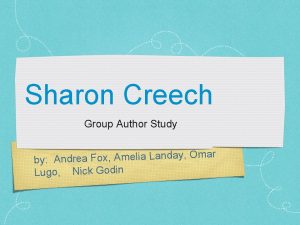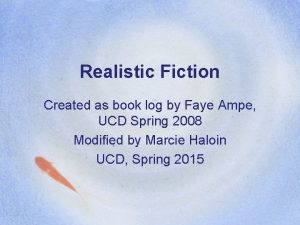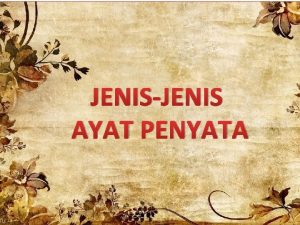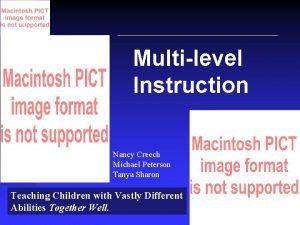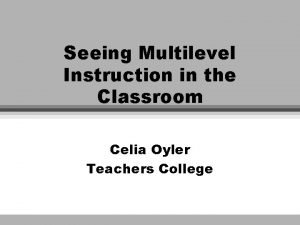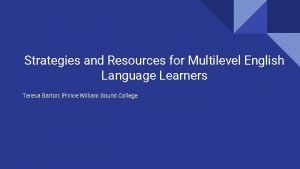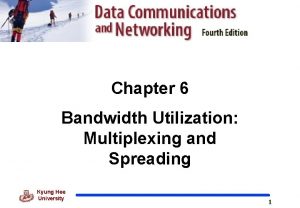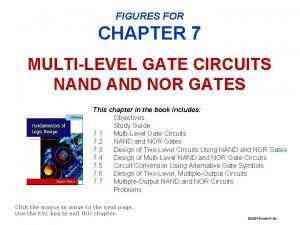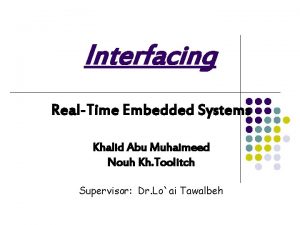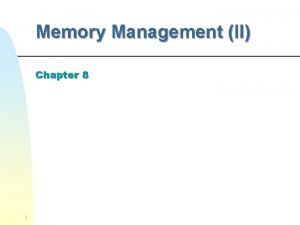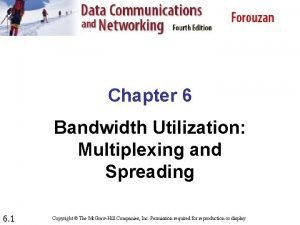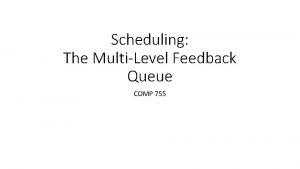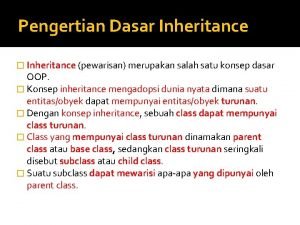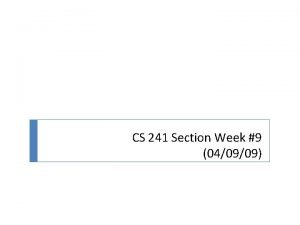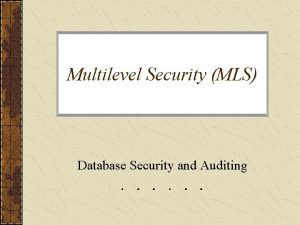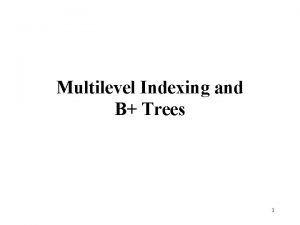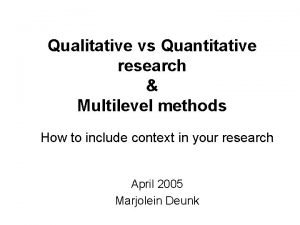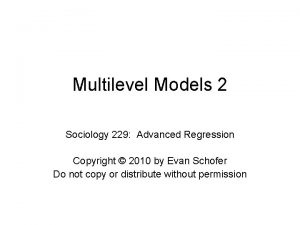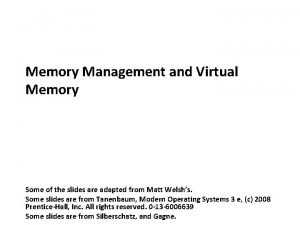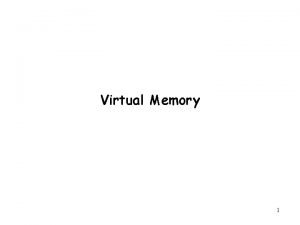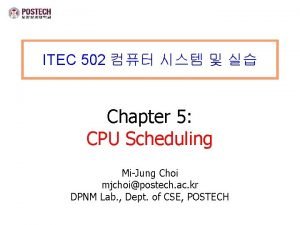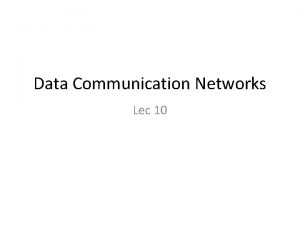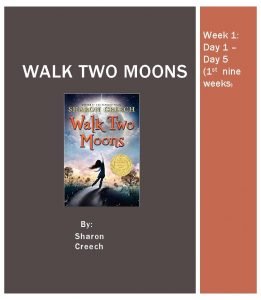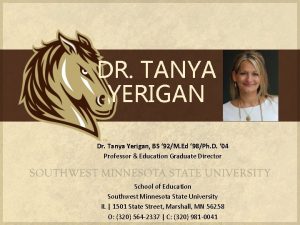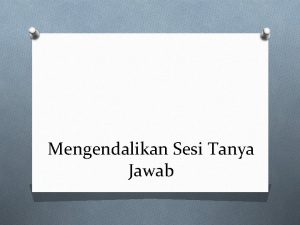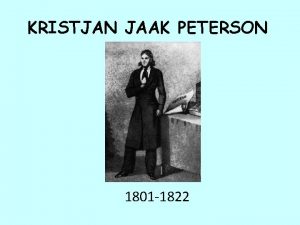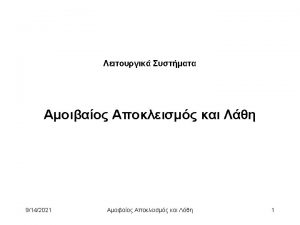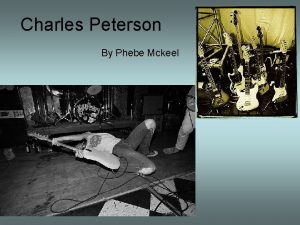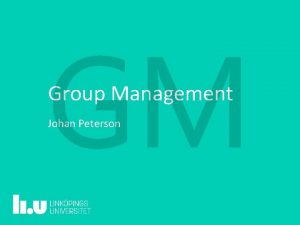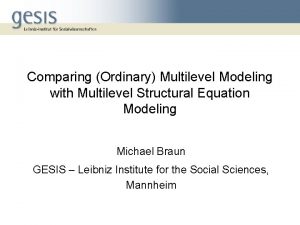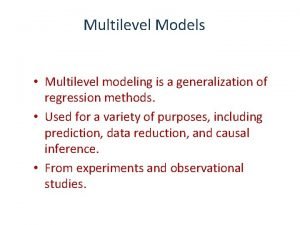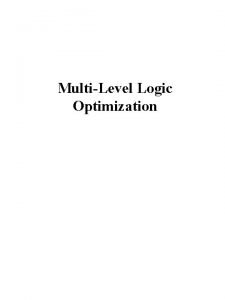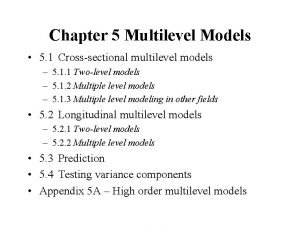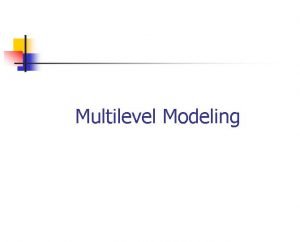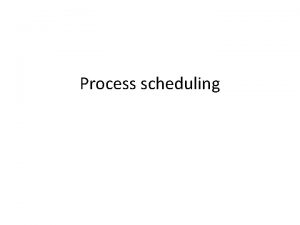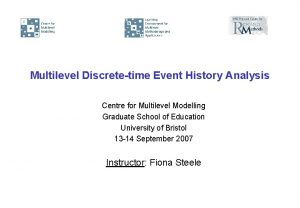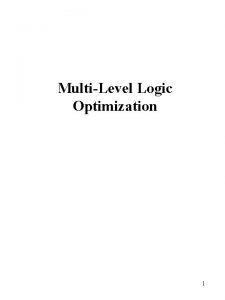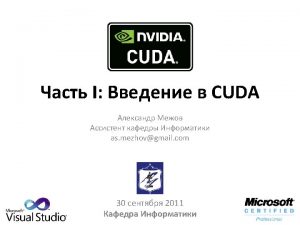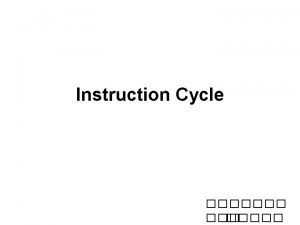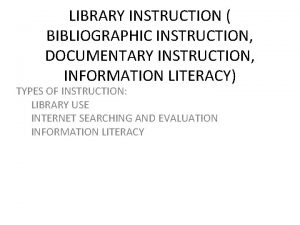Multilevel Instruction Nancy Creech Michael Peterson Tanya Sharon





























- Slides: 29

Multi-level Instruction Nancy Creech Michael Peterson Tanya Sharon Teaching Children with Vastly Different Abilities Together Well.

Why Multi-level Instruction? n One level instruction doesn’t work -- 3 -7 grade levels in every class. n Welcoming segregated students back to our classes as inclusive teachers n n Building on and expanding whole language theory and practice Building political alliances in an uncertain time

MANAGING DIFFERING ABILITY LEVELS in CLASSROOMS • One size fits all <-> Segregation • Stable ability group • Pull out / pull aside -- at the side or back of the class. • Adapting curriculum. Individual adaptations of teaching approach or modification of expectations. Best • Differentiated instruction. • Multi-level teaching Learning activities allow children at different levels to learn together.

What is. . . Authentic Multi-level Instruction n n n Students of very different abilities levels Learn at their own level of challenge With support and guidance Through authentic learning activities In heterogeneous groups Without stable ability grouping

PRINCIPLES OF AUTHENTIC, MULTI-LEVEL INSTRUCTION 1. 2. 3. 4. 5. Authentic learning. Multiple levels. Scaffolding. Higher order thinking. Inclusive, heterogeneous grouping. 6. Integrated skill learning. 7. Focus on meaning and function. 8. Multi-modal. 9. Building on the strengths of children. 10. Fostering respect. 11. Student interests, choices, power, and voice. 12. Collaborative learning. 13. Reflection. 14. Growth and effortbased evaluation.

GROUPING IN A MULTI-LEVEL CLASSROOM Heterogeneous, inclusive grouping q Interests, friendships, self-selected ‘just right’ work q Ability grouping -- coping with the dangers q ü ü No ongoing, stable ability groups Specific short-term skill needs -- minilessons Vary compositions often, daily Based on choice of children (shifting power)

Strategies for Authentic Multi-level Instruction 1. Individual learning activities with materials, resources, and expected output at different levels of ability n n n n Personal best and ‘just right’ work Individual student goals Reading and writing workshop. Individualized spelling lists. Partner reading / writing Authentic homework projects – eg. project on the hero of a family member. Publishing student work Personal museums

Strategies for Authentic Multi-level Instruction 2. Projects and activities that allow roles at differing levels of complexity and ability n n Thematic unit Workshop projects linking literacy, science, math, social studies – eg. studying local community – writing, interviewing, building model of historical community, making play. n n Dramatic play of reading / writing Whole class learning project – eg. class hatching chickens, studying and discussing their behavior, taking roles in their care. n Collaborative exploration of topic of study.

Strategies for Authentic Multi-level Instruction 3. Whole group activities that allow processing & understanding with needed scaffolding at differing ability levels n n Morning meeting & message Read aloud Choral reading Sharing chair

Strategies for Authentic Multi-level Instruction 4. Structures that provide for specific skill development without stable ability grouping. n n Comprehension aids – story maps, webs, etc. Student experts Mini-lessons Student conferences

Strategies for Authentic Multi-level Instruction 5. Technology that expands the capacity of all learners. n n n n Internet. Graphics, word processors, more. Talking software. Voice command writing. Communication devices. Adapted computer input and output. Specialized switches. And more. A living laboratory on the interaction of technology and human capability.

Strategies for Authentic Multi-level Instruction 6. Assessment and evaluation that centers on teaching and learning. n Competency assessments observations, performance and work sample assessments n n n Portfolios Self-assessment Publishing student work Student-led conferences Multi-modal demonstrations of learning – story, illustration, skit, song, poem, etc. n Focus on effort, goals, growth

AUTHENTIC MULTI-LEVEL INSTRUCTION Bringing excellence & equity, Ethnic and disability diversity, Academic learning & community. . . Together.

Instruction & Grouping MEANING focus with skills imbedded n n n Morning message Literacy centers Reading & writing workshop. Word and sound minilessons. Conferencing. Student-led conferences. SKILLS / FACTS focus Direct instruction -phonemic awareness & phonics. n Fill in blank worksheets. n Lecture, text, multiple choice tests Heterogeneous - Ability Grouping n

DESIGNING INSTRUCTION FOR DIVERSE LEARNERS 1. Design Teaching for Diverse Learners 2. Adapt &And Modify Teaching 3. Evaluate and Revise Teaching



Examples of Authentic Multi-level Teaching

TEACHING STRATEGIES For Authentic Multi-level Teaching 1. 2. 3. 4. 5. 6. Integrative, thematic units. Classroom workshop. Authentic learning experiences. Small group activities. Representing to learn Reflective assessment.

EVALUATION & ASSESSMENT n n n Rubrics Competency-based assessment Student self and peer assessment Student-led conferences Grading: Effort and growth

Building Community to Learn n n Morning greeting and meeting Classroom meetings Student experts Jobs for all Mini-lessons Collaborative learning Peer buddies Circle of friends Community building games Teach and model respect for differences








Whole Schooling FIVE PRINCIPLES for School Renewal Empower citizens in a democracy Include all: all children learn in regular classes together across culture, ethnicity, language, ability, sex, & age. Authentic, multi-level instruction: teach connected to real, meaningful activities at multiple levels of ability. Build community & support learning: build community and mutual support in the classroom and school. Use specialized resources (special education, Title I) to support students, parents, and teachers. Partner: build real collaboration within the school and with families & community Macarthur Elementary
 Facts about sharon creech
Facts about sharon creech Elements of realistic fiction
Elements of realistic fiction Sensory memort
Sensory memort Jenis ayat tanya
Jenis ayat tanya Multi level instruction
Multi level instruction Celia oyler
Celia oyler Institutional aggression
Institutional aggression Individualized instruction vs differentiated instruction
Individualized instruction vs differentiated instruction Direct instruction method
Direct instruction method Teaching multilevel esl classes
Teaching multilevel esl classes Sample size calculations in multilevel modelling
Sample size calculations in multilevel modelling Bandwidth utilization multiplexing and spreading
Bandwidth utilization multiplexing and spreading Multilevel nand gate
Multilevel nand gate Multilevel bus architecture
Multilevel bus architecture Multilevel paging in os
Multilevel paging in os Multiplexing and spreading
Multiplexing and spreading Gantt chart os
Gantt chart os Multilevel feedback queue scheduling example
Multilevel feedback queue scheduling example Apa yang dimaksud dengan pewarisan inheritance
Apa yang dimaksud dengan pewarisan inheritance Multilevel page tables
Multilevel page tables Multilevel security in database
Multilevel security in database Multilevel security model
Multilevel security model Multilevel indexing
Multilevel indexing Multilevel model equation example
Multilevel model equation example Advanced regression and multilevel models
Advanced regression and multilevel models Virtual memory linux
Virtual memory linux Multilevel page tables
Multilevel page tables Preemptive sjf
Preemptive sjf Multilevel scheme in data communication
Multilevel scheme in data communication Miller indices visualizer
Miller indices visualizer
